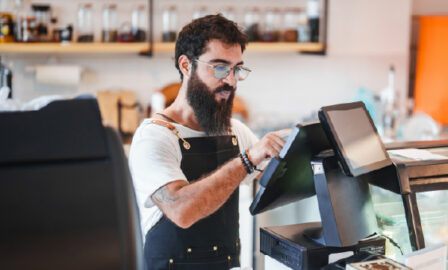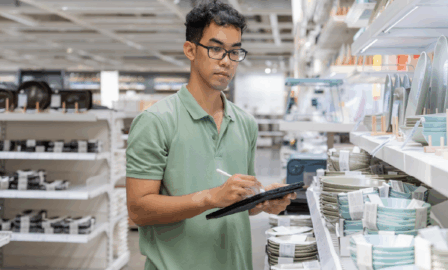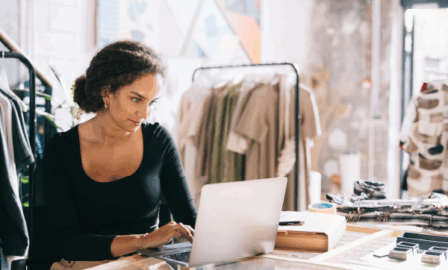Exploring the Latest Technology Innovations in Retail
Retail technology is constantly evolving and becoming more advanced with great strides in digital capabilities and changing customer preferences shaping the industry. As we continue in 2024, Artificial Intelligence (AI) is still a leader in retail technology breakthroughs as it introduces solutions we previously didn’t know were possible. With eCommerce growing 26.4% since the pandemic, retail technology continues to advance in its capabilities, helping to create personalized and convenient online shopping journeys as well as seamless omnichannel experiences. In this piece, we explore some of the newest breakthroughs and technology innovations in retail.
Technology Innovations in Retail
1. Technology for Consumers
Refining the customer experience with technology is increasingly important as shoppers become more tech-savvy and demand digital and convenient solutions. Below are a few examples of innovative retail technology that is enhancing consumer experiences:
Augmented Reality (AR)
Augmented Reality (AR), while not a new concept, continues to bridge the gap between online and in-store retail experiences, helping both refine the customer shopping experience and drive sales for retailers while changing the ways customers can interact with products in-store and online. One of the most difficult parts of online retail shopping for items like clothes, accessories, and even furniture is visualizing the product in use. With AR, customers can surpass this complication with technology that allows you to visualize products virtually through gamification and technology-driven dressing rooms.
These applications can play a huge role in driving sales, with shoppers using AR having a 19.8% higher likelihood of purchasing an item during a session than customers who didn’t. This may look like virtual mirrors as dressing rooms for in-store purchases or an in-app VR capability for online shoppers. For example, furniture giant Ikea has implemented 3D replica technology to simulate an Ikea-furnished room, helping online shoppers better plan and visualize the products that they’re considering without the guesswork.
Mobile Point-of-Sale
A seamless point of sale (POS) system can be revolutionary for organizations trying to increase their conversion rates. The POS software value market is growing, and users are also spending more money through mobile POS payments, with an estimated average of $2,100 per person per year in 2023. Although non-traditional checkout systems like mobile ordering have been trending for years, mobile POS could reconstruct the traditional checkout experience. Rather than the fixed checkout areas in stores, sales associates can be prepped with devices using cloud-based-POS systems to check out customers anywhere in the store, facilitating a faster and more effective checkout process.
Voice Assistance
Voice shopping generated $40 million annually last year, with customers utilizing virtual assistants like Siri and Alexa to make purchases. This technology can better reach shoppers who may not be able to come to a physical store, possibly due to busy schedules or for those who may find in-store shopping to be inaccessible. Natural language processing (NLP) and advances in AI have improved the voice shopping experience by enhancing the processing of words from a multitude of dialects and languages. Now shoppers can notify their voice assistant when they need to add something to their grocery list or make an instant purchase, such as through Amazon’s Alexa, further making shopping fast, easy, and convenient. This technology is opening opportunities for all individuals and allowing retailers to cater to the needs of a more diverse population of shoppers.
2. Technology Supporting Retailers
While retail technology is commonly used to enhance the shopping experience and boost convenience for customers, it can also be beneficial for retailers themselves. Below are a few new technologies retailers are using to refine their processes:
Retail Video Analytics
While we know brick-and-mortar stores have been using their security cameras to watch for shoplifting and safety for decades, these cameras have lots of new capabilities as technology advances. Security cameras using AI technology can pick up certain behaviors like the removal of goods, face recognition, and suspicious movements. This allows a better system of security monitoring by emitting real-time alerts when suspicious behaviors are detected, rather than checking the cameras after an incident when the merchandise may already be missing, and the shoplifter is gone. It’s also important to mention that AI cameras may help eliminate confirmation bias where stores are predisposed to thinking one person may have committed a crime over another.
In addition to security enhancements, retail video analytics can produce insights into customer movement and behavior as well. Retailers are constantly trying to catch the eyes of their shoppers by displaying their products in the most visually appealing and convenient manner, and stores can leverage video analytics technology to uncover what displays may generate the most foot traffic and make placement decisions from those insights.
RFID and QR codes
If you’re a typical in-store retail shopper, you know employees are always looking in the back to see if they have another size or item you can’t find. Knowing what inventory is in the store can be difficult to navigate in large areas with lots of items. With mobile POS systems allowing shoppers to check out according to their convenience, brick-and-mortar stores need to be equipped with a thorough inventory management system. RFID and QR codes can help this process with the scan of tags, as employees can find what inventory is in the store.
For example, fashion retailer River Island uses RFID tags on their items of clothing so shoppers can scan the tag and see what items are present in the store and if they come in a different color or size. This enhances the shopping experience as customers can thoroughly vet the store for their favorite item rather than walking away when they can’t find it. Additionally, this technology can improve security measures as retailers can see missing items from their inventory, too.
3. Recommendations for Retailers
Adopting new technology can always be a challenge for organizations, but preparing your teams can help the transition go smoother. Ensure you are supporting your other business processes and knowledge of the industry as you consider implementing new technology. Below are some recommendations for retailers considering new technology:
Understand Shopper Preferences
Knowing the needs of your customer base is very critical in any industry but specifically in retail as preferences are constantly changing. Part of leveraging technology and software is understanding your shoppers, otherwise the technology won’t reach its full potential. As such, having a deep understanding of your consumer base’s wants and demands is the best way to program your technology and keep your customers coming back.
Set Metrics and KPIs
Understanding what technology is working correctly for your specific retail store is key. There is no technology that is “one program fits all,” so measuring how well a certain technology is performing for your store and organization is an effective way to narrow down what technology is right for you.
Leverage and Embrace Technology
Currently, AI is changing the retail experience both for retailers and shoppers alike. However, technology is constantly evolving into more advanced and practical solutions. As such, staying ahead with new software and technology trends allows your organization to remain competitive and agile. Continuous learning and improvement are important for any organization when looking at long-term growth.
Clarkston Can Help
With new technologies and capabilities being the way of the future for many brands, learning about retail technology is the first step to improving your organization’s brand engagement. For more guidance on retail technology and how your brand can leverage it to improve, contact our team today.
Subscribe to Clarkston's Insights
Contributions from Leah Harding



